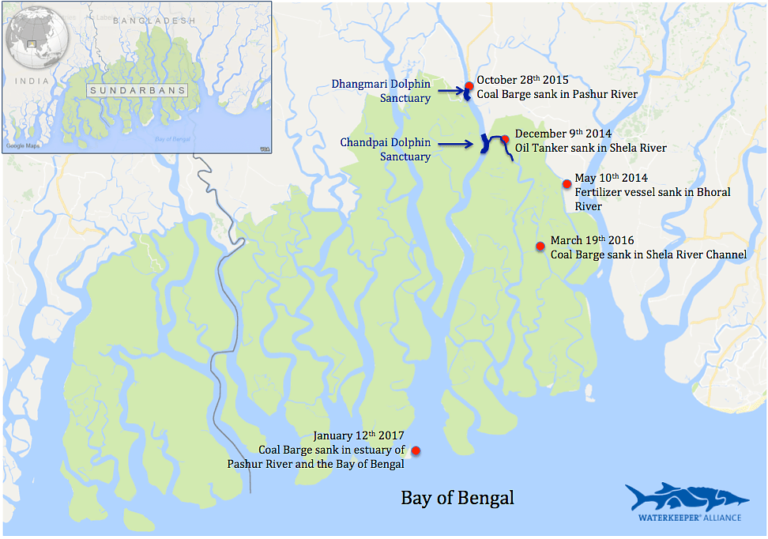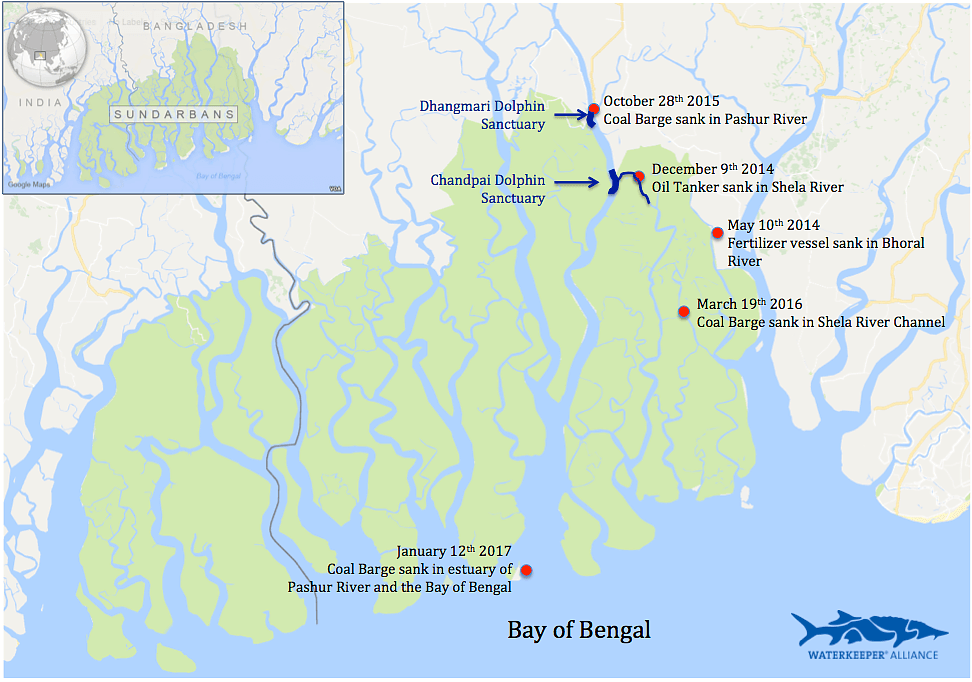Coal barge carrying 1,000 tonnes of coal sinks in the Sundarbans World Heritage site
By: Donna Lisenby

DHAKA, BANGLADESH — On Friday January 13th, the MV Aichgati, a large bulk cargo vessel carrying 1,000 tonnes of coal, sank in the estuary of the Pashur River in the Sundarbans World Heritage Site. In addition to the large amount of coal, hundreds of gallons of fuel oil, batteries and other toxic contaminants may now be polluting the Sundarbans.
The is the fifth time a vessel has sunk in the Sundarbans over the past two years. In December 2014, an oil tanker capsized in the Chandpai Dolphin Sanctuary on the Shela River, spilling and spreading 350 m3 of fuel oil across at least 40 km of the waterway. Five months later in May 2015, a cargo vessel sank, polluting the Bhola River with 200 tonnes of potash. In October 2015, a barge transporting 570 tonnes of coal capsized near the Dhangmari Dolphin Sanctuary in the Pashur River. In March 2016, a cargo vessel transporting 1,245 tonnes of coal sank in the Shela River. The waterways flowing through the Sundarbans are home to the Dhangmari and Chandpai dolphin sanctuaries, created to protect the rare Irawaddy and Ganges dolphins.
Sharif Jamil, Coordinator of Waterkeepers Bangladesh said, “ If the Rampal coal plant is built, it will require hundreds more coal ships and barges to travel through the Sundarbans. This is one of the many reasons why the World Heritage Centre (WHC) and International Union for the Conservation of Nature (IUCN) concluded that the proposed Rampal power plant poses a serious threat to the Sundarbans and should be cancelled.”
The governments of India and Bangladesh are aggressively moving forward with the construction of the proposed Rampal coal-fired power plant which will dramatically increase the shipping of coal, coal ash and gypsum pollutants through the Sundarbans.
“All these shipping accidents show that the leaders of India and Bangladesh are not taking steps to protect the Sundarbans; rather, they are attempting to increase damage and destruction,” said Pashur River Waterkeeper Noor Alam. “This accident again proves the carelessness of the government towards the protection of the Sundarbans and justifies the call to stop construction of Rampal on the banks of River Pashur.”

“Five recent episodes of ships capsizing have created a cumulative impact that endangers the rare aquatic ecology of the Sundarbans,” said Donna Lisenby, Clean & Safe Energy Campaign Manager for Waterkeeper Alliance. “The Rampal coal plant must be stopped before it further imperils the World Heritage Site.”
In addition to cancellation of Rampal, Waterkeeper Alliance and Waterkeeper Bangladesh supports the shipping recommendations made by the WHC and IUCN in the June 2016 Monitoring Mission Report (p. 23):
Recommendation R5
Enforce the permanent closure of the Shela River to all vessel traffic, national and international, and apply speed limits and effective control measures for night and poor weather conditions for vessels navigating along the Pashur River.
Recommendation R6
Develop an effective action plan and emergency response facility in consultation with all relevant stakeholders to react to any future shipping incidents in a timely and coordinated manner, and consistent with the recommendations made in the United Nations Development Programme (UNDP) oil spill assessment report.
There was grossly inadequate emergency response that failed to remove of sunken vessels and their toxic cargo in a timely manner in all past 5 shipping disasters in the Sundarbans. Adherence to the WHC and IUCN recommendations is necessary to prevent more capsized ships from spewing additional pollution into one of the world’s most important, water-dependent World Heritage Sites.
Waterkeepers Bangladesh and Pashur River Waterkeeper will continue to monitor this latest shipping disaster to assess whether proper clean-up, mitigation and enforcement are completed by the government of Bangladesh.
CONTACT: Donna Lisenby, Waterkeeper Alliance, [email protected] , 704-277-6055
运输1千吨煤炭的运煤船沉没于巽达班斯世界自然文化遗产中
达卡,孟加拉国 – 1月13日周五,一艘运输1千吨煤炭的大型驳船沉没于巽达班斯世界自然文化遗产的巴施户珥河中。除了大量的煤炭之外,数百加仑的燃料油,电池,及其他有害物质很可能也正在污染巽达班斯。

这已经是两年以来巽达班斯发生的第五次驳船沉没事件。2014年12月,一艘运油船倾覆在舍拉河的查安德派河豚保护区中,泄漏350立方米的燃料油并污染了河道的40多公里。五个月以后,2015年5月,一艘运货船沉没于波拉河中并泄露出200吨钾盐。2015年10月,一艘运输570吨煤炭的运煤船倾覆在靠近当马力河豚保护区的巴施户珥河中。巽达班斯河道网络的两个河豚保护区当马力和查安德派致力于保护稀有的依洛瓦底和恒河河豚。
护水者孟加拉国协调员谢里夫•贾米尔说(Sharif Jamil),“如果郎帕尔煤厂修建了,那穿过巽达班斯的运煤船和驳船就会增加数百艘。这是世界遗产中心(WHC)和国际自然资源保育联盟(IUCN)断定严重威胁着巽达班斯的拟议中郎帕尔发电厂应该取消的一个决定因素。“
印度和孟加拉国两个国家的政府正在积极进行兴修拟议郎帕尔燃煤发电厂。此厂会大量增加穿过巽达班斯的煤炭,煤灰,和石膏污染物运输活动。
“这些驳船事故都证明印度和孟加拉国的政府领导并没有采取措施保护巽达班斯;反而,他们正在试图增加损伤和破坏,”巴施户珥护水者努尔•爱拉姆说。“此事件再次表明政府对保护巽达班斯的粗心并提供了合理证据以停止巴施户珥河岸上郎帕尔厂的建设。”
“近期五个船舶倾覆事件加起来的影响对巽达班斯稀有的水生态造成了很大的危险,”护水者联盟清洁和安全能源行动主管唐娜•利森比说。“郎帕尔电厂必须停止施工,在其进一步威胁此世界遗产之前。”
除了取消郎帕尔项目之外,护水者联盟和孟加拉国护水者们还支持WHC和IUCN在2016年6月监察使命报告(第23页)里提出的运输活动推荐:
推荐 R5
实施舍拉河作为国家及国际运输船通道的永久封闭。针对巴施户珥河中的驳船,建议使用速度限制以及天气不良时的有效控制措施。
推荐R6
在所有利益相关者的咨询下,制定一个有效的行动计划并建设一个应急反应中心以确保我们能够快速,协调地应付任何未来发生的运输事故。此计划应该按照联合国开发计划署(UNDP)的石油泄漏评估报告中所提出的建议。
巽达班斯过去发生的五个运输事件的应急反应工作都严重不足,没能及时清除沉没船舶本身及其有毒的货物。我们必须严格按照WHC和IUCN所提的建议以保护全球最重要,最依赖于水的世界遗产之一受倾覆运输船泄露出来的污染。
孟加拉国护水者团和巴施户珥河护水者将继续监督此运输事件并评估孟加拉国政府是否完成清洁,恢复,和执法工作。
联系人:Donna Lisenby, Waterkeeper Alliance, [email protected] , 704-277-6055